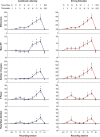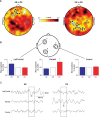Local experience-dependent changes in the wake EEG after prolonged wakefulness
- PMID: 23288972
- PMCID: PMC3524543
- DOI: 10.5665/sleep.2302
Local experience-dependent changes in the wake EEG after prolonged wakefulness
Abstract
Study objectives: Prolonged wakefulness leads to a progressive increase in sleep pressure, reflected in a global increase in slow wave activity (SWA, 0.5-4.5 Hz) in the sleep electroencephalogram (EEG). A global increase in wake theta activity (5-9 Hz) also occurs. Recently, it was shown that prolonged wakefulness in rodents leads to signs of "local sleep" in an otherwise awake brain, accompanied by a slow/theta wave (2-6 Hz) in the local EEG that occurs at different times in different cortical areas. Compelling evidence in animals and humans also indicates that sleep is locally regulated by the amount of experience-dependent plasticity. Here, we asked whether the extended practice of tasks that involve specific brain circuits results in increased occurrence of local intermittent theta waves in the human EEG, above and beyond the global EEG changes previously described.
Design: Participants recorded with high-density EEG completed 2 experiments during which they stayed awake ≥ 24 h practicing a language task (audiobook listening [AB]) or a visuomotor task (driving simulator [DS]).
Setting: Sleep laboratory.
Patients or participants: 16 healthy participants (7 females).
Interventions: Two extended wake periods.
Measurements and results: Both conditions resulted in global increases in resting wake EEG theta power at the end of 24 h of wake, accompanied by increased sleepiness. Moreover, wake theta power as well as the occurrence and amplitude of theta waves showed regional, task-dependent changes, increasing more over left frontal derivations in AB, and over posterior parietal regions in DS. These local changes in wake theta power correlated with similar local changes in sleep low frequencies including SWA.
Conclusions: Extended experience-dependent plasticity of specific circuits results in a local increase of the wake theta EEG power in those regions, followed by more intense sleep, as reflected by SWA, over the same areas.
Figures







Similar articles
-
Neural and behavioral correlates of extended training during sleep deprivation in humans: evidence for local, task-specific effects.J Neurosci. 2015 Mar 18;35(11):4487-500. doi: 10.1523/JNEUROSCI.4567-14.2015. J Neurosci. 2015. PMID: 25788668 Free PMC article. Clinical Trial.
-
Period-amplitude analysis reveals wake-dependent changes in the electroencephalogram during sleep deprivation.Sleep. 2013 Nov 1;36(11):1723-35. doi: 10.5665/sleep.3138. Sleep. 2013. PMID: 24179307 Free PMC article.
-
Why Does Sleep Slow-Wave Activity Increase After Extended Wake? Assessing the Effects of Increased Cortical Firing During Wake and Sleep.J Neurosci. 2016 Dec 7;36(49):12436-12447. doi: 10.1523/JNEUROSCI.1614-16.2016. J Neurosci. 2016. PMID: 27927960 Free PMC article.
-
Going local: insights from EEG and stereo-EEG studies of the human sleep-wake cycle.Curr Top Med Chem. 2011;11(19):2423-37. doi: 10.2174/156802611797470268. Curr Top Med Chem. 2011. PMID: 21906022 Review.
-
Cortical and subcortical EEG in relation to sleep-wake behavior in mammalian species.Neuropsychobiology. 1993;28(3):154-9. doi: 10.1159/000119017. Neuropsychobiology. 1993. PMID: 8278030 Review.
Cited by
-
The Theta Paradox: 4-8 Hz EEG Oscillations Reflect Both Sleep Pressure and Cognitive Control.J Neurosci. 2022 Nov 9;42(45):8569-8586. doi: 10.1523/JNEUROSCI.1063-22.2022. Epub 2022 Oct 6. J Neurosci. 2022. PMID: 36202618 Free PMC article.
-
Automated sleep state classification of wide-field calcium imaging data via multiplex visibility graphs and deep learning.J Neurosci Methods. 2022 Jan 15;366:109421. doi: 10.1016/j.jneumeth.2021.109421. Epub 2021 Nov 22. J Neurosci Methods. 2022. PMID: 34822945 Free PMC article.
-
Eyes Open on Sleep and Wake: In Vivo to In Silico Neural Networks.Neural Plast. 2016;2016:1478684. doi: 10.1155/2016/1478684. Epub 2016 Jan 14. Neural Plast. 2016. PMID: 26885400 Free PMC article. Review.
-
Intracortical mechanisms of single pulse electrical stimulation (SPES) evoked excitations and inhibitions in humans.Sci Rep. 2024 Jun 14;14(1):13784. doi: 10.1038/s41598-024-62433-0. Sci Rep. 2024. PMID: 38877093 Free PMC article.
-
Lateralized tactile stimulation during NREM sleep globally increases both slow and fast frequency activities.Psychophysiology. 2023 Mar;60(3):e14191. doi: 10.1111/psyp.14191. Epub 2022 Sep 25. Psychophysiology. 2023. PMID: 36153813 Free PMC article.
References
-
- Vyazovskiy VV, Cirelli C, Pfister-Genskow M, Faraguna U, Tononi G. Molecular and electrophysiological evidence for net synaptic potentiation in wake and depression in sleep. Nat Neurosci. 2008;11:200–8. - PubMed
-
- Tononi G, Cirelli C. Sleep function and synaptic homeostasis. Sleep Med Rev. 2006;10:49–62. - PubMed
Publication types
MeSH terms
Grants and funding
LinkOut - more resources
Full Text Sources
Other Literature Sources

